 |
| Elephants at the Shire River |
If you’re unfamiliar with AfricanParks, it’s an NGO set up in 2000 to rehabilitate and manage national parks that had been neglected and poached out of animals. After 3 years of negotiation, Majete became the guinea pig - the first reserve in AfricanParks’ portfolio.
 |
| Giraffe heads |
And it was a daunting challenge - almost no animals were left after most had been poached out, trees were being felled for charcoal at an alarming rate and no tourists had visited in 3 years! (Check out AfricanParks’ story here)
Fast forward to 2020 and it is now Malawi’s only Big-5 reserve, and in 2017 they actually translocated 150 elephants out of the park as they had too many since being introduced over a decade earlier. At 700km2, Majete is actually larger than Liwonde NP (the other notable park in Malawi), but the main tourist area that has all weather roads is quite small.
 |
| Hidden lions |
The sanctuary or tourist area covers the northern section of the reserve (along with the Mkulumadzi concession) and is situated along the most important river in Malawi, the Shire River.
 |
| Nyala female |
The southern section is largely undeveloped with the exception of some 4WD roads that lead to a few waterholes, we've only ventured down south in the rainy season once, but with the high grass, we're waiting until the dry season when that part should come into its own.
 |
| Very young elephant |
We visited Majete for the first time in August 2020 in the middle of the dry season, but didn’t get back to the reserve until New Year’s Day 2021. We spent most of the dry season in Liwonde chasing cheetahs (you can read all about our experiences here) but once the rains started, those roads became a black cotton slippery mess and it was time to go back to Majete. And we were not disappointed…
 |
| Baboon having a drink |
Unlike the vast marsh plains in Liwonde, Majete is quite dense bush with a sandy riverbank along the eastern side. The south is a lot more open grassland and that is where you will find the big herds, including buffalo and sable (there are 1500 sable in the park!) so we look forward to exploring that more in the dry season.
 |
| Male lion of the Thawale pride |
The riverside drives loop between the main road and the river, going from thick bush and old trees to the grass covered banks. When we first visited there didn’t seem to be any animals coming to the fast flowing river to drink, but over time we’ve seen plenty of impala and waterbuck and nice herds of elephants at the river’s edge, plus a couple of grumpy hippos out of the water.
 |
| Kudu male |
Considering how fast the river flows, we’re amused that there are actually hippos in the water, but there are quite a few and we often see quite big crocodiles sunning themselves on the banks too.
Inland there are no real open areas unless you count the airstrip next to the campsite (more on that later…) but 2 hides have been built along the main Njati middle road, named after the dry rivers that must have once flowed into the Shire river.
 |
| Warthog pushing up mud |
Because we have mainly spent the rainy season in Majete, we don’t spend much time at the hides since the animals don’t need to go there to drink, but the one time we were there in the dry season we were treated to eland, elephant and giraffe all coming to drink along with the plentiful animals such as nyala, waterbuck and warthog.
We have even heard that a black rhino comes to drink at one of the hides in the dry season, so it will be something that we will be looking out for when the park dries up.
 |
| Snake with baby palm-thrush |
But now with the rains and puddles of water all over the park, including the drainage ditches and dry riverbeds, there is just so many options for water-dependent animals that we rather spend our time along the river and anywhere the cats tend to hang out ;)
 |
| How to rest an elephant trunk |
-------------------------------Elephants-------------------------------
We’ve been surprised about the amount of elephants - they’ve been more than we expected. We did know that they had moved 200 elephants from Majete to Nkhotakota NP as part of AfricanParks’ 500 elephants translocation and had assumed that there weren’t too many left. But there are still plenty.
 |
| Elephant enjoying the cool mud |
There’s something special about seeing a herd of a dozen or so elephants drink and bathe in the Shire River in the warm afternoon sun.
 |
| Elephant herd at the river |
In fact, the elephant’s love of bathing and being able to drive along the river gives plenty of opportunities to catch these huge animals act like kids at a swimming pool ;)
 |
| Bull elephant waiting for the herd |
The elephants are generally calm, but there are a few angry bulls around - we’ve encountered one that seemed to be waiting for us so that he could charge at us… twice! It notches up the adrenaline even higher when the bush is dense so you can’t easily turn and get out of his way.
 |
| Elephant herd at the river |
Luckily the first time we saw him coming from a long way away and were able to u-turn in time, and the second time we had just passed the spot where he came crashing out the bush, allowing us to hightail it out of there! So needless to say the lone bulls make us very wary!
 |
| Baby elephant leading the herd |
-------------------------------Hippo-------------------------------
A river park is always going to have hippos in the water and Majete is no exception.
 |
| Eating mud to get minerals |
Mostly they’re just hanging in the fast moving water, but in the afternoons some of them head out to graze and the light is really good to get some nice relatively close up photos.
 |
| Hippo at the river |
We were lucky enough to find one that was happily scooping up dirt into his mouth - the assumption is that they are getting minerals to supplement the diet of grass - very amusing to watch this living one ton excavator ;)
 |
| Yawning hippo |
-------------------------------Giraffe-------------------------------
In 2018, 13 giraffes were introduced to the reserve and the first two times we found them they were on the middle road of the reserve (Njati road) near the southern hide, amongst the dense bush.
 |
| Chilling on the runway |
Luckily we also came across them on the airstrip one trip. It was a really good sighting of 8 of them, with one pair fighting and another pair mating.
 |
| Mating giraffes |
Giraffe mating is a pretty slow affair with a lot of build up (from what we’ve seen before) so getting there just in time to see the deed being done was lucky.
 |
| Fighting giraffes |
We believe that Majete are also planning to bring in more giraffes in 2021 to boost the genetic diversity of the population.
-------------------------------Antelope-------------------------------
 |
| Nyala bulls fighting |
 |
| Nyala antelope on the road |
It looks most similar to a bushbuck but bigger with more impressive horns. We were quite excited to finally see these animals, but they soon become as commonplace as the impalas as they are plentiful in the park ;)
 |
| Nyala licking a rock for minerals |
Waterbuck are all over the park as well, they really are one of the most common antelope that we see in Malawi.
 |
| A very recognisable waterbuck in Majete |
There are 2 main species of waterbuck and the one found in Malawi is the Common Waterbuck, distinguishable from the Defassa waterbuck of West and Central Africa by the very defined white ring around the tail.
 |
| Waterbuck - named after their comfort in water |
As usual - in almost any park where they occur, impalas are the most abundant of the antelope. And of course since we’re going in the rainy season, there is an explosion of the population with the birth of the offspring in time for the season of plenty.
 |
| Impalas are plentiful in the park |
After being quite sedentary the last few months, the male impalas have started to chase one another and play fight - all gearing up for the rutting season which starts in April following the rains.
 |
| Rutting starts after the rainy season |
The rest of the antelope are seen in small numbers, but again the dense bush probably plays a part in visibility. There are quite a few kudu antelopes around and they’re always a treat to see, especially with the imposing horns of the males.
 |
| Magnificent kudu bulls |
We’ve seen the odd sable here and there, but look forward to catching the herds in the South when the dry season rolls around. The eland, as usual, can be seen running away from us (so frustrating!) and we finally caught our first sighting of some skittish Hartebeest when coming from the Southern region.
 |
| Bushbuck are rarely seen in the open |
-------------------------------Others-------------------------------
 |
| Grazing zebra |
There are quite a few zebras around, much more than we initially thought. In the beginning we only saw a couple, but each time we go back we catch more and more milling in the bushes.
 |
| Zebra using a scratching post |
Maybe the rains have fanned them out into small groups and during the dry season they will congregate at the waterholes and river in larger herds.
 |
| Puffadder |
Surprisingly, buffalo is something we have hardly seen. In fact, if memory serves we’ve only spotted one dagga boy in a small muddy waterhole and then another in the woodland a few weeks later - probably the same bull.
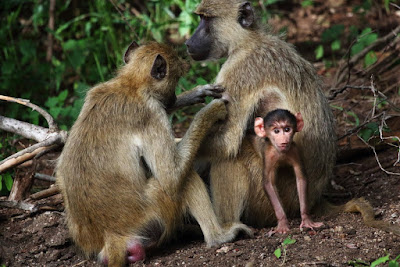 |
| Baby baboon looks to play |
Again, we’ve been told that the big herds can be found in the south where there is open grassland and the few waterholes (away from the river) will come into their own when there isn’t rain water around every turn.
 |
| Sausage fruit are a common food for baboons |
The usual suspects are all over the park. It’s amazing that when AfricanParks took over Majete there weren’t even warthog around - now they’re common sightings.
 |
| Warthog chasing another from his mud wallow |
Of course, baboons are everywhere and are often the most reliable animal to give an indication that a predator is around. Because of the dense bush, it’s normally the baboons that first spot a cat around so don’t dismiss a bunch of baboons in trees alarm calling like crazy - we’ve found quite a few predators that way!
 |
| Grooming is a common occurrence in baboon society |
Otherwise, the tortoises and terrapins can be found in the rainy season, along with quite a few snakes that we’ve spotted - including one that raided a palm thrush nest to grab the baby bird. And a highly unusual sighting - a monitor lizard running off with a woodland kingfisher!
 |
| Monitor lizard with a woodland kingfisher |
Rhino… our elusive animal. We still haven’t managed to catch a black rhino in Malawi. After spending so much time in Liwonde (although admittedly not in the rhino’s preferred habitat) and not seeing one, our bad luck continues in Majete.
 |
| Tortoises are plentiful in the rainy season |
We assume it will be a chance encounter and also think we’re probably hanging around in the wrong area of the reserve to catch them, but so far no one has given us any good intel as to where we could encounter them (except for the titbit of the waterhole hide in the dry season) so our search for them continues…
 |
| Mushrooms growing in elephant dung |
Of course, it shouldn’t be surprising since our search priority remains the cats. Luckily Majete has provided some nice sightings over the last couple of months we’ve been visiting there.
 |
| Basking terrapin |
-------------------------------Lion-------------------------------
 |
| Thawale pride on the airstrip |
The first time we went to Majete it was in winter in the dry season and we had seen the lions in the bush, but it was so thick that it was just an ear here and a tail there.
 |
| Young lions looking for a mongoose in a fallen tree |
Considering that was the height of the dry, we weren’t expecting much when we finally returned in the wet.
 |
| Sleepy male lion |
The bush was thicker and more lush - what were the chances of actually catching the main pride anywhere in the open? Well, we hadn’t anticipated the airstrip!
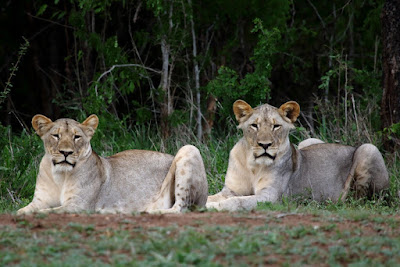 |
| Siblings |
The main pride in the tourist area consists of a male, 2 big females and 3 subadult cubs and their home range is between the Shire river and the Thawale lodge. Now, the campsite is slap in the middle of that and the airstrip is right next to the campsite.
 |
| Flehmen grimace |
And the lions like to hang around on the airstrip, probably because it’s the only open area and they can sit and watch the impala that gather on the same runway. Our first meaningful sighting of this Thawale pride was on the airstrip.
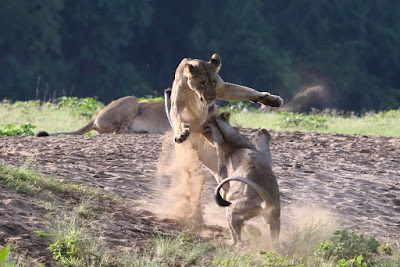 |
| Playing lionesses |
We’d heard that the lions were in the area that morning after passing by the Thawale Lodge at about 3am. Some of the lodge guests had seen some of the lions, but unfortunately despite our searching we couldn’t catch them.
 |
| Playful lions |
We did know where they were though - they were in the thicket next to the airstrip if the baboon and impala alarm calls were anything to go by.
 |
| Dominant male and female of the Thawale pride |
By lunchtime they still hadn’t appeared so we decided to have lunch and do some birding in the campsite in case they started to move and the alarm calls started again. Sure enough, the baboon alarms came in the afternoon, and we rushed to the airstrip 2 minutes away to be greeted by the pride of 6 sitting in the sun.
 |
| Big yawn |
It only lasted about 10 minutes before they crossed the runway and headed into the bush again, but it was our first clear sighting of the big cats, and we had it all to ourselves. We did return later but they were nowhere to be seen, the hope was now that they would be still hanging around and back on the runway in the morning.
 |
| Quick drink outside the campsite |
They were back on the runway by evening and spent the whole night roaring - there’s nothing quite like the sound of lions close by! So the next morning we were out like a shot and there they still were - minus one of the lionesses - on the runway.
 |
| The lions were very playful |
We were entertained by them for over an hour; first the subadults played with each other before the young male tried to stalk some nervous impala, ruining any chance of the mother stalking them.
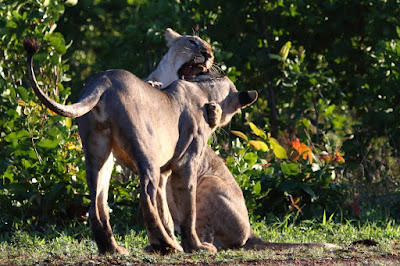 |
| Nothing like chewing on your sibling's ear |
This pride’s territory spans from the lodge to the river - a length of about 5km. We have caught them mainly around the campsite, and didn’t actually think they went down to the river at all.
 |
| Young lioness posing on a fallen tree |
One morning, after hearing the male roaring at 3am right at the campsite waterhole, we drove out expecting to see him right there - nothing! We did some tracking of his spoor that we found and finally caught him on the main road - we followed him for a long time - he was definitely on a mission.
 |
| Looking aggressive - but it was only the end of a yawn |
And in the end we didn’t need to look for the rest of the pride - he led us directly to them - resting right on the banks of the river. It was a cool morning and the young lionesses were playful - first hunting for a hapless mongoose in a fallen tree before play fighting with each other and then the big females, before they all headed off into the bush for the day - a really special sighting on the riverbank.
 |
| Chilling at the Shire River |
There are about 25 lions in total in Majete. At least one pride of 4 is in the Mkulumadzi concession in the north and the others are mainly to the south, but the main pride that is seen most often is this Thawale pride.
 |
| Playing around |
We’ve been lucky enough to catch them a number of times in the open making for nice sightings and shots. And we look forward to catching some of the others in the south in time to come.
 |
| Just chilling at the waterhole near the campsite |
-------------------------------Leopard-------------------------------
 |
| Our first sighting of a leopard in Malawi |
Now of course leopards are always hard to find - they are shy, elusive and masters of disguise. The photos that we’d seen of Majete leopards all seemed to be from night drives so we weren’t expecting a lot in terms of these spotted cats.
 |
| We found him where we'd been told he hangs around - the bridge |
But still, outside of Nyika NP (a high altitude park that covers the Nyika plateau), Majete is the only place that we can see leopards in Malawi after about 6 were introduced over the years from 2011. It was a long shot, but one that has paid off and what kept us going back ;)
 |
| Looking back before dashing off |
We’d spoken to one of the guides who had told us that the new bypass road was the best place to look for leopard as one had been spotted near the main bridge.
 |
| A young, bold and curious leopard |
Okay, that’s at least a good place to start. Then we happened to run into someone that we’d met at Liwonde. Samwel had been a freelance guide and had often camped at the same campsite we would while his guests stayed in the lodge.
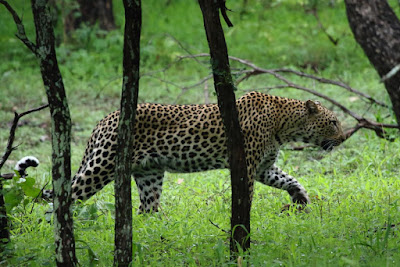 |
| Adult female leopardess |
When we met him at Majete he’d just started working there as a guide and told us that he’d seen not one but 3 leopards! That had been the previous week and it was a mother with 2 subadults around the same area that the other guide had told us.
 |
| The female subadult is a lot more skittish |
This was a better lead than we’d thought so we decided to head out that afternoon just after a heavy rainstorm and scout the area. We checked around but couldn’t find anything and knowing the lead was actually a week old, decided to head back to the campsite and make coffee.
 |
| This young male is very confident |
We’d just had our coffee when Sam rocked up to get some guests for a game drive and asked us if we’d seen the leopards. Thinking that he was asking a general question, we responded that we hadn’t. “No, no - they’re there now!!” What?! He’d come to pick up his guests early since he’d spotted them near to where he said he’d seen them last.
 |
| Spots on a rock |
So he suggested we follow him and not long after that we got our first sighting of a young male leopard. Unfortunately the other 2 had already disappeared into the bush, but he seemed quite brave and posed while watching us for a while before following the other 2 leopards.
 |
| We found her on the rock 2 days in a row |
We caught them later as well walking amongst the trees, but were never able to get them all in the same frame, so that now remains our mission.
 |
We’ve actually caught them a few times since then, but while the sighting is relatively good, the photo opportunities haven’t been as much, so that is the main drawcard for us returning there week after week ;) And the young male seems to be the most comfortable with cars, he’s the one we see most often, so that bodes well for the future that he is getting habituated to cars. There is also another leopard that seems to hang around the campsite - we’ve heard him at night a few times and he’s been spotted by the guides dashing across the road, so hopefully one day we’ll catch him too.
-------------------------------Hyena-------------------------------
 |
| Finally a shot of a hyena in Malawi |
It took us over 6 months for us to finally get a photo of a spotted hyena in Malawi. There seems to be very few of them around in the national parks, and our only encounter with them was a skittish one that came around our campsite one night in Liwonde NP.
 |
| He was surprisingly calm |
We hear them now and then and had heard them from the Majete campsite, but we finally found one that was relaxed enough to be photographed one morning when we were looking for leopards. The hyena was actually on the same road the leopard frequents - I think he may have been looking for the leopards too ;)
 |
| Very chilled |
--------------------------Other predators--------------------------
 |
| Some more lions as we don't have shots of cheetahs |
There are cheetahs on the reserve, but they are rarely seen. Well, there was only one when we started visiting and they were always trying to escape. Then they swapped that cheetah with one from Liwonde and have since introduced a few more - at least 2 are from Pilanesberg in South Africa.
 |
| Always check the runway - the lions love hanging out there |
And those 2 seem to be showing up in the tourist area - we spotted one very early morning, but they had disappeared into the bush before we could even reach for our cameras. But in all honesty, after all our great sightings of cheetah in Liwonde, we weren’t targeting those spotted cats at this reserve, so look forward to seeing them clearly one of these days.
 |
| We followed him for about half an hour until he led us to the pride |
We assume there are jackals on the reserve as well, but there hasn’t been a trace of one so far. There have been a couple of servals that have been released recently that were rescued as pets and rehabilitated, so we may have a chance of seeing them, but we’re not holding our breath ;)
 |
| Spoiling a hunt by allowing the prey to see him ;) |
-------------------------------Birds-------------------------------
 |
| Crowned hornbill |
Surprisingly we haven’t had as much luck as we’d expected in the birding department.
 |
| Bearded woodpecker |
Considering the big trees along the riverbank, we’d thought that we’d be seeing many more birds than we have.
 |
| Bohm's bee-eater |
The river flows too fast to have the shore birds that would normally occur, but we have seen a few specials - including the uncommon Racket-tailed roller.
 |
| Racket-tailed roller |
Over the migratory season we’ve also seen a few old favourites like the Broad-billed roller and a couple of Southern carmine bee-eaters.
 |
| Arnot's chat (m) |
We’ve found the best place to bird is actually the campground with its big trees and nearby waterhole.
 |
| Striped kingfisher |
We’ve spotted some really cool birds there, including a Narina trogon, a resident Red-headed weaver, and 2 lifers for us - a Black cuckooshrike and a Black cuckoo.
 |
| Red-headed weaver |
In fact, we’ve heard a number of cuckoos in the rainy season - Black, Red-chested, Diederik’s, Klaas’ and African Emerald - but hearing them is always a lot easier than seeing them!
 |
| Speckled-throated woodpecker |
-------------------------------Overall-------------------------------
 |
| Black-bellied bustard |
Majete was always going to be our alternative reserve to visit if we couldn’t go to Liwonde, but the reserve is really holding its own.
 |
| Retz's helmetshrike |
The cats that we’ve seen have actually been a pleasant surprise, the elephants have been more plentiful than we were anticipating and the overall game diversity and sightings has been pretty good.
 |
| Martial eagle |
So overall, we will keep coming back - especially to test out that Southern section in the dry!






No comments:
Post a Comment